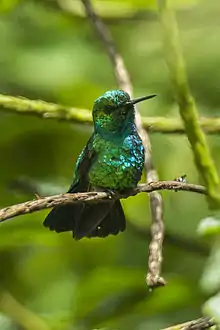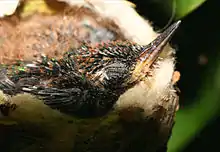Blue-tailed emerald
The blue-tailed emerald (Chlorostilbon mellisugus) is a hummingbird found in tropical and subtropical South America east of the Andes from Colombia east to the Guianas and Trinidad, and south to northern Bolivia and central Brazil.
| Blue-tailed emerald | |
|---|---|
 | |
| Scientific classification | |
| Kingdom: | Animalia |
| Phylum: | Chordata |
| Class: | Aves |
| Order: | Apodiformes |
| Family: | Trochilidae |
| Genus: | Chlorostilbon |
| Species: | C. mellisugus |
| Binomial name | |
| Chlorostilbon mellisugus | |
| Synonyms | |
|
Trochilus mellisugus Linnaeus, 1758 | |
Taxonomy
The blue-tailed emerald was formally described by the Swedish naturalist Carl Linnaeus in 1758 in the tenth edition of his Systema Naturae under the binomial name Trochilus mellisugus.[2] The specific epithet combines the Latin mel meaning "honey" and sugere meaning "to suck".[3] Linnaeus's description was typically brief and it was unclear which species he was describing. When he updated his Systema Naturae for the twelfth edition in 1766 Linnaeus added citations including one to the "all-green humming-bird" that had been described and illustrated by the English naturalist George Edwards in his Gleanings of Natural History.[4][5] The identify still remained uncertain but in 1950 the American ornithologist John T. Zimmer argued that the species Trochilus mellisugus described by Linnaeus could only have been the blue-tailed emerald.[6] This has been generally accepted.[7] Zimmer designated the type locality as Cayenne in French Guiana.[6] The blue-tailed emerald is now placed in the genus Chlorostilbon that was introduced by the English ornithologist John Gould in 1853.[7][8]
Seven subspecies are recognised:[7]
- C. m. caribaeus Lawrence, 1871 – northeast Venezuela, Trinidad and Netherlands Antilles
- C. m. duidae Zimmer, JT & Phelps, 1952 – Cerro Duida (south Venezuela)
- C. m. subfurcatus Berlepsch, 1887 – south Venezuela, Guyana and Rio Branco region (northwest Brazil)
- C. m. mellisugus (Linnaeus, 1758) – Suriname, French Guiana and northeast Brazil
- C. m. phoeopygus (Tschudi, 1844 – upper Amazonia
- C. m. napensis Gould, 1861 – northeast Peru
- C. m. peruanus Gould, 1861 – southeast Peru and east Bolivia
Molecular phylogenetic studies have shown that the blue-tailed emerald is sister to the glittering-bellied emerald.[9][10][11]
Description
The blue-tailed emerald is 7.5 cm (3 in) long and weighs 2.6 g. The black bill is relatively short and straight. The male has a brilliant green plumage, with white thighs and a dark metallic blue tail (clearly forked in the northern part of its range; slightly so in the central and southern part). The female average smaller than the male and also differ by the grey-white underparts, a blackish ear patch, a short white supercilium/post-ocular streak and white-tipped outer tail feathers. The song is a pleasant twittering, and the call of this species is a pebbly tsip.
Distribution and habitat
It is a bird of savanna, scrub, cultivation and similar semi-open woodland. In the Amazon, where generally uncommon and more localized than in the northern part of its range, it mainly occurs at forest edge and in várzea.
Behaviour
The female lays her eggs in a small cup nest, similar to that of the ruby-topaz hummingbird, placed on a horizontal tree branch. Incubation is 13 days with a further 18 days to fledging.
Blue-tailed emeralds feed on insects and nectar.

References
- BirdLife International (2017). "Chlorostilbon mellisugus". The IUCN Red List of Threatened Species. IUCN. 2017: e.T22687313A112399190. doi:10.2305/IUCN.UK.2017-1.RLTS.T22687313A112399190.en. Retrieved 13 January 2018.
- Linnaeus, Carl (1758). Systema Naturae per regna tria naturae, secundum classes, ordines, genera, species, cum characteribus, differentiis, synonymis, locis (in Latin). Volume 1 (10th ed.). Holmiae (Stockholm): Laurentii Salvii. p. 121.
- Jobling, James A. (2010). The Helm Dictionary of Scientific Bird Names. London: Christopher Helm. p. 249. ISBN 978-1-4081-2501-4.
- Linnaeus, Carl (1766). Systema naturae : per regna tria natura, secundum classes, ordines, genera, species, cum characteribus, differentiis, synonymis, locis (in Latin). Volume 1, Part 1 (12th ed.). Holmiae (Stockholm): Laurentii Salvii. p. 192.
- Edwards, George (1758–1764). Gleanings of Natural History, exhibiting figures of quadrupeds, birds, insects, plants &c... (in English and French). Part 3. London: Printed for the author, at the College of Physicians. pp. 316–318, Plate 360 fig. 1.
- Zimmer, John Todd (1950). "Studies of Peruvian birds. No. 58. The genera Chlorostilbon, Thalurania, Hylocharis and Chrysuronia". American Museum Novitates: No. 1474: 4–5. Cite journal requires
|journal=(help) - Gill, Frank; Donsker, David; Rasmussen, Pamela, eds. (January 2021). "Hummingbirds". IOC World Bird List Version 11.1. International Ornithologists' Union. Retrieved 31 January 2021.
- Gould, John (1853). A Monograph of the Trochilidae, or Family of Humming-Birds. Volume 5. London: self. Plate 355 and text (Part 5 Plate 14). The 5 volumes were issued in 25 parts between 1849 and 1861. Title pages of all volumes bear the date of 1861.
- McGuire, J.; Witt, C.; Remsen, J.V.; Corl, A.; Rabosky, D.; Altshuler, D.; Dudley, R. (2014). "Molecular phylogenetics and the diversification of hummingbirds". Current Biology. 24 (8): 910–916. doi:10.1016/j.cub.2014.03.016.
- Stiles, F.G.; Remsen, J.V. Jr.; Mcguire, J.A. (2017). "The generic classification of the Trochilini (Aves: Trochilidae): Reconciling taxonomy with phylogeny". Zootaxa. 4353 (3): 401–424. doi:10.11646/zootaxa.4353.3.
- Hernández-Baños, B.E.; Zamudio-Beltrán, L.E.; Milá, B. (2020). "Phylogenetic relationships and systematics of a subclade of Mesoamerican emerald hummingbirds (Aves: Trochilidae: Trochilini)". Zootaxa. 4748 (3): 581–591. doi:10.11646/zootaxa.4748.3.11.

